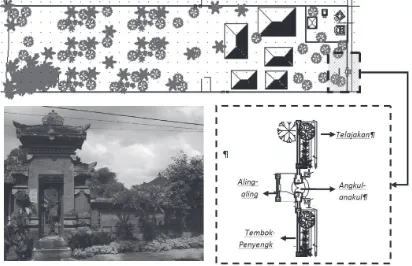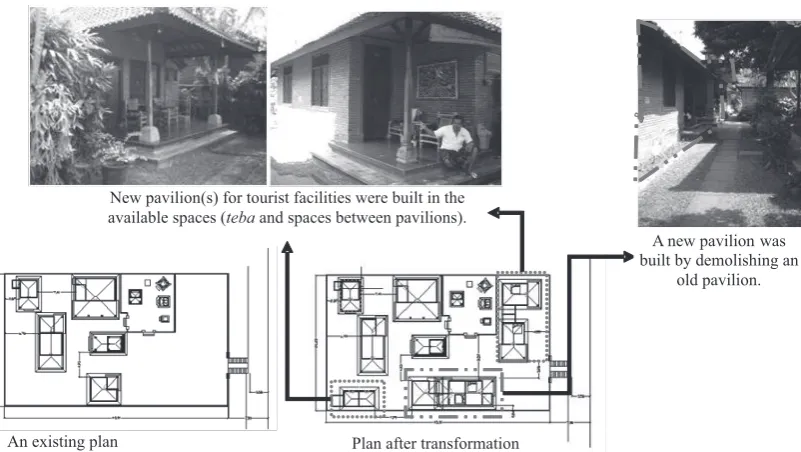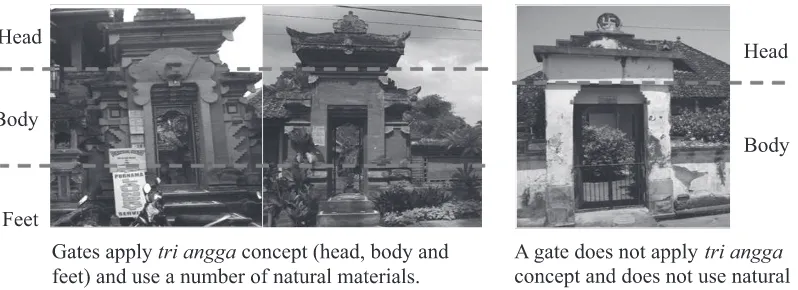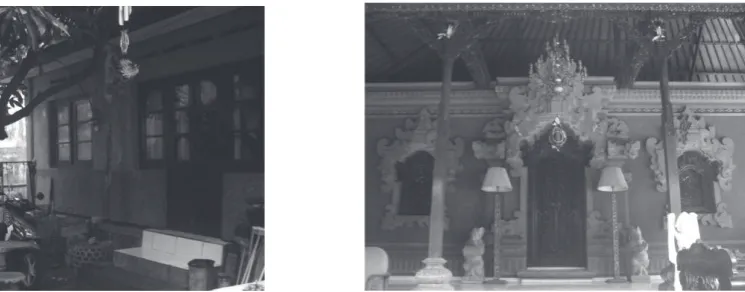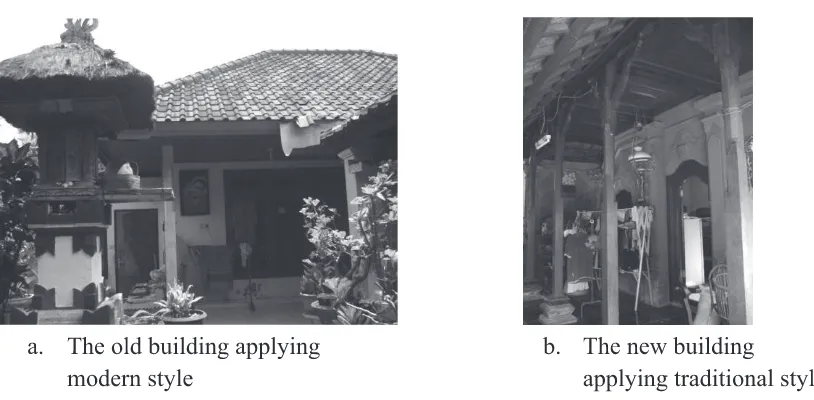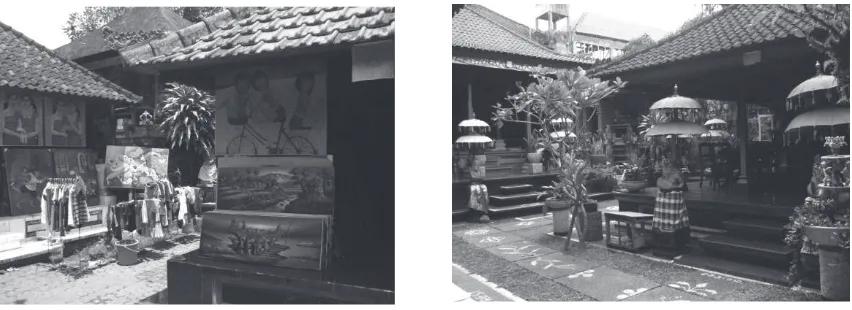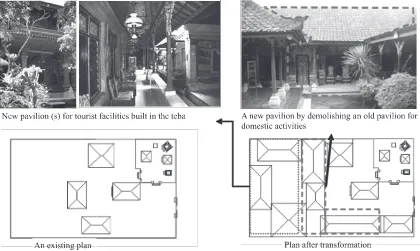2 (2) 120 - 131 ©UB 2013 University of Brawijaya Malang, Indonesia http://apmba.ub.ac.id
Corresponding author Email: [email protected]
Asia-Pacific Management and Business Application, 2, 2 (2013): 120-131 ISSN : 2252-8997
The Transformation of the Traditional Balinese House
for Tourist Facilities: Managing a Home-Based
Enterprise and Maintaining an Architectural Identity
I Dewa Gede Agung Diasana Putraa* Mirjana Lozanovskab
Robert Fullerc
aUniversity of Udayana Bali, Indonesia; bc Deakin University, Australia
Abstract
As a tourist destination, Bali relies on its culture, which includes socio-cultural activities and the architectural form of the traditional Balinese house inspired by the Hindu Balinese religion, as the main core to attract tourists. The increasing number of tourist arrivals has motivated people to transform their traditional houses become tourist facilities to improve their economic condition. The traditional house-compound becomes a home-based enterprise with the construction of new buildings in their house. This construction has changed the setting, spaces and forms of the house, which are components of an architectural identity. This phenomenon encourages questions about the new relationship between a home-based enterprise and an architectural identity. Is there a conflict between a home-based enterprise as a strategy to gain an economic benefit and an architectural identity as an expression of Balinese culture? Is there an interdependent relationship between them? By examining the setting, forms and transformation process of the traditional Balinese house, this study discusses the continuity of an architectural identity alongside home-based enterprises in the physical transformation of tourist villages. In tourist villages, the architecture identity and home-based enterprise have an interdependent relationship where the architectural identity is an asset to attract tourists and, by running tourist facilities as home-based enterprises, the Balinese people maintain the architectural identity of their houses.
Keywords
home-based enterprise, traditional Balinese house, transformation, architectural identity
Received: 9 October 2013; Accepted: 12 November 2013; Published Online: 1 January 2014
Introduction
Bali is a major tourist destination in Indonesia that relies on its culture, which includes socio-cultural activities and the architectural form of the traditional
Asia-Pacific Management and Business Application, 2, 2 (2013): 120-131 and cultural activities related to the human
lifecycle, including birth, marriage and death (Hobart, 1978). Balinese cultural activities constituting regular rituals can be easily witnessed by tourists in the villages and traditional Balinese houses, and in some cases, tourists can be directly involved.
The intensive interaction with tourists influences the culture of Bali, including the traditional Balinese house, as the people build tourist facilities to gain economic benefits. New buildings have been constructed which has resulted in a transformation of the house-compound that describes the history and evolution of the dynamic household lifestyle and identity (Ahmadi 2007). The house was only a place to perform domestic and socio-cultural activities, now has an additional function, namely tourist activities. The trading activities that used to be carried out in the market, now also take place in the traditional Balinese house. Many kinds of tourist facilities have been built in the houses to anticipate the increase in the number of tourists, which has nearly doubled in a decade from 1.4 million in 2000 to 2.6 million in 2010 (Statistic Bureau of Bali, 2011). The house has become a home-based enterprise where new buildings have been constructed either adjacent to existing pavilions, around a courtyard (by demolishing old potential asset to obtain economic benefit from tourist activities; on the other hand, the transformation could potentially alter the physical identity of the house.
This paper explores the strategies conducted by the Balinese to transform their traditional houses to obtain economic benefit from tourist activities. To achieve this purpose, 749 houses in four tourist villages: Sanur, Kuta, Ubud and Kamasan; were recorded by visual documentation in streets and within the compounds. While Sanur, Kuta and Ubud are popular tourist villages in Bali (Picard 1996), Kamasan is not considered a popular tourist village. The form and style of the houses were analysed visually, to understand the texture of the condition of the houses and villages. Information obtained from nine home owners,about the process of physical transformation and the activities in the house, was investigated to establish a correlation between architectural identity and strategies of the people in managing their tourist facilities. This paper initially describes the influences of tourism on the traditional house in the four tourist villages. The components of the houses that change in the house transformation are then presented and finally the attempts of the people to manage their business in the transformed house are discussed.
The Tourist’s Arrival, the Traditional Balinese House are Transformed for Tourist Facilities
The Balinese village is generally divided into three parts: parahyangan,
pawongan and palemahan respectively associated with the divine, human beings and environment (Ashrama, Pitana and Windia, 2007; Hobart, Ramseyer and Leemann, 2001). The traditional Balinese house is a part of pawongan,
alongside a palace called puri (in some villages), village facilities including a meeting room called wantilan, traditional neighbourhood community buildings called bale banjar and a market called
Asia-Pacific Management and Business Application, 2, 2 (2013): 120-131 functions. Traditionally, the market was
the only place for economic transactions in a village where people brought the goods they produced and sold or bartered them to obtain other goods (Krause, 1988). On the other hand, the house compound was a place that accommodated the domestic and socio-cultural activities of the occupants (Oliver, 1997; Lim and Beng, 1998). A traditional house has been defined as an artefact produced by the collaboration of many people over many generations and handed down by previous generations (Rapoport, 1969; Kowaltowski, Watrin and Pina, 2007). It describes traditions, social systems, family systems, traditional values and beliefs (Kostof, 1995, Wang,
1997; Gelebet, 1998). In Bali, based on people’s beliefs, the traditional houses, described as a number of pavilions enclosed by walls, is related to a human body where it has a head represented by a family temple, a body represented by a series of pavilions and feet represented by a back yard (teba) (Covarrubias, 1974, Hobart, Ramseyer, Leemann, 2001). Walls called tembok pekarangan, a gate called angkul-angkul, a small wall behind the angkul-angkul called aling-aling
and a space between a front wall and the road called telajakan are traditional components that express the image of the traditional house and village landscape (Figure 1).
Figure 1. The Angkul-Angkul, Tembok Penyengker, and Telajakan in the Traditional
House The development of tourism has changed many aspects of some villages, including its pattern as well as the family house compound (Sukawati 2004). The houses have been transformed for tourist facilities in order to accommodate tourist activities.
Asia-Pacific Management and Business Application, 2, 2 (2013): 120-131 today can also be seen in the houses.
The traditional settlements that were previously represented by the presence of traditional walls, gates and the spaces between the wall and the road have been now supplanted by tourist facilities. By visual documentation in four villages and counting the houses both transformed and untransformed for tourist facilities, this study noted that Kuta, a very popular coastal tourist destination, has undergone massive transformation where 69% of the houses have been transformed for tourist facilities. This percentage is the highest of the four villages, while Kamasan that is not a popular tourist destination has the lowest percentage (13%). These figures indicate how the number of tourists has influenced the level of traditional house transformation. The more popular the tourist destination, the greater the number of traditional houses transformed for tourist facilities.
The tourist activities in inland Ubud, regarded as the cultural capital of Bali, are in the centre of the village, where there is an enclave of traditional Balinese houses. There is an intense interaction between tourists and house owners, which has resulted in the transformation of 61% of the traditional houses for tourist activities. On the other hand, the centre of tourist activities in Sanur is not in the centre of the village but on the beach, on the outskirts of the village. Here, the percentage of transformedhouses for tourist facilities is much lower (31%) than the percentage in Kuta and Ubud. The people in Kuta and Ubud have more opportunities to utilize their traditional houses as an asset to obtain economic benefits than those in Sanur. Therefore, the location of tourist activities has influenced the degree of transformation so that the closer the tourist activities are to the location of the traditional Balinese houses, the greater the level of transformation.
The Transformation of the
Traditional Balinese House
The transformation of traditional houses has changed the image of the houses themselves, as well as the villages. The front wall and the telajakan have changed enormously as a result of the tourism that have no front wall and telajakan. This shows that tourism directly influences the presence of the wall and the telajakan.
The other front component of the house is the traditional gate (angkul-angkul), and this is the visual identity of the house. Even though the house is hidden behind tourist facilities, the angkul-angkul is a sign to recognize the house as a traditional Balinese dwelling. This phenomenon can be seen in Ubud where most (79%) of the traditional gates still exist. From the gates, people can easily identify the presence of a group of the traditional houses among the tourist facilities. On the other hand, without the angkul-angkul, the presence of the house is hard to recognize, and is the case in most (64%) houses in Kuta and Sanur. The entrance of the house is a space between the tourist facilities which makes it hard to recognize the presence of the houses from the street. One needs to physically enter the house and observe the various components of the house such as a courtyard, pavilions, a family temple and a back yard.
Asia-Pacific Management and Business Application, 2, 2 (2013): 120-131 Others are being built adjacent to the
existing buildings (Figure 3). All of these have changed the setting of the house and influenced the form of the courtyard.
Figure 2. The New Pavilions were Built by Demolishing Old Pavilions and in Available Space
Figure 3. The New Pavilions were Built Near the Existing Pavilions
Architectural Identity as a Strategy to Obtain Economic Benefit
The setting of the traditional Balinese house has been transformed to fulfil
Asia-Pacific Management and Business Application, 2, 2 (2013): 120-131 enterprise as a strategy to gain an economic
benefit and an architectural identity as an expression of Balinese culture?
An identity expresses people’s understanding of the ‘sameness’ of the tradition and culture among the members of society, as well as ‘otherness’ or sharp distinctiveness from non-members (Brubaker and Cooper, 2000). Based on the philosophy of tri hita karana, the Balinese people express their identity through their traditions and cultural activities which are different from others. Architecture, as one of those traditions, is a medium for the Balinese to show their identity that is different from other societies. The philosophy inspires concepts related to landscape of Bali from the universe physic to the human physic division. As a part of universe, the landscape of Bali is dividedin three parts called tri loka: the upper world for God (swah loka), the intermediate world for human beings (bwah loka) and the lower world for demons (bhur loka) (Meganada, 1990; Hobart, Ramseyer, Leemannn, 2001; Eiseman 1989). The
tri loka concept then inspires a tri angga
concept as a human physic division. Based on this concept, the world is divided into three traditional values such as utama, madia and nista, or a head, a body and feet. Utama or the head means high, lofty or most sacred value, madia or the body means middle or neutral and nista or the feet means below or most profane value
(Gelebet 1986, Meganada, 1990; Hobart, Ramseyer, Leemannn, 2001; Eiseman 1989). Based on this concept, every part of a building is divided into a head, called
hulu, a body, called pengawak and feet called suku, constituting the feature of the Balinese architectural form and style (Gelebet, 1986). Moreover, the style is also presented through the use of natural materials (Putra, 2003; Budihardjo, 1998). The form and natural materials express the identity of the Balinese architecture applied in many parts of the traditional house including the pavilions, the walls and the traditional gate.
Some traditional houses transformed for tourist facilities still have walls and traditional gates that can express their identity (see Section 3). Most of the houses, 75 % in Sanur, 73% in Kuta and 96% in Ubud, still apply the Balinese architectural style in which they are divided into the three parts (a head, a body and feet) and use a number of natural materials (Figure 4). These conditions are different in the less popular tourist destination of Kamasan. In Kamasan, 45% of walls and gates in the house are not in the traditional style. This phenomenon shows that tourism influences the awareness of the people to maintain and preserve the architectural identity of their houses. This awareness can be seen further in the transformation process that changes over time to meet the demands of residents and tourists.
Figure 4. Traditional Gates (angkul-angkul) in Tourist Villages
Asia-Pacific Management and Business Application, 2, 2 (2013): 120-131 Figure 4. Traditional Gates in Tourist Villages
Body The physical transformation is the
historical process of the house changing from the old to the new. A new pavilion in Kuta, shown in Figure 5, standing side-by-side with an old pavilion demonstrates this phenomenon. The ownerbuilt new building uses a number of natural materials including brick, sandstone and wood to show the identity of the traditional style. The old, that was a bale daja of the house where the owner performed rituals related to a human lifecycle, uses plaster with
cement and painted walls for both the interior and exterior parts of the building. The walls do not apply the tri angga
concept where they are not divided into three parts representing a head, a body and feet of the walls. This style had been a prestigious style during the period of colonial era and 1970s. At that time, applying this style expressed the dignity, social and economic status of the owner in the village.
Figure 5. The Old (Left) and New Pavilion (Right) Showing the Process of Transformation in Kuta
Along with the increase of the tourist activities in the village, the owner built a new bale daja next to the old one. The old pavilion now no longer functions as the bale daja and has been replaced by the new one. The ‘new’ applies the traditional form, including the proportion applying the tri angga concept and uses a number of natural materials such as red bricks, sandstone, wooden columns and clay roof tiles, especially on the exterior of the building. The demands of a modern lifestyle and maintenance have influenced the use of materials for the floor and the interior of the pavilion, and many manufactured materials including plaster with cement and paint for the interior walls, gypsum for ceiling and ceramic for floor are used. The pavilion has now
become a hybrid building that combines the elements of traditional architecture represented by its external appearance and proportions, and the elements of advanced building materials used for the interior and the floor. The expression of the new building is now more luxurious than the old one to meet the demands of the modern lifestyle of the occupants and tourists. The building, however, still applies the traditional expressions to meet the traditional activities. In this pavilion, the occupants can perform ceremonial activities as always, conduct daily activities, chat with friends and relatives and welcome tourists.
Asia-Pacific Management and Business Application, 2, 2 (2013): 120-131 old pavilion called kekantoran to the
traditional architectural style for the new pavilion. From this, the attempt of the owner to go forward to the traditional architectural style as a strategy to attract tourists can be seen. In this process, the traditional Balinese architectural style is undergoing a process of continual transformation that is parallel to the development of modernity of the culture in communities. It is influenced by many factors such as advance of economic activities, technology and tourism (Lim and Beng, 1998, Logan 1994). The style undergoes a journey, as suggested by Appadurai (2006), from commodity to singularity and back, where the style has experienced the transactions with social relations. Using Appadurai’s terminology, the traditional Balinese architectural style has undergone the journey from singularity in the pre-colonial era to junk during the colonial era and recently back to commodity for tourists. In the pre-colonial era, the house applied the traditional style to accommodate domestic and socio-cultural activities. During the
period of the colonial era and the 1970s, the traditional style had been left behind and was seen as primitive or old style by the people who had adjusted their house by applying the modern style. Along with the increase in tourism development, the traditional style has been seen as a commodity and an asset that expresses a transaction between the people and the tourists. To attract tourists, the traditional architectural style has been reinvented and reapplied in the house so that the house can accommodate domestic and socio-cultural activities as well as meeting the demands of the modern lifestyle for the occupants and tourists.
Similar phenomena have also occurred in Sanur and Kamasan where the modern style has been changed to a traditional style. For example, the owner of one house in Sanur demolished the old pavilions and built the new one that now expresses the traditional style, by applying Balinese architectural form and using a number of natural materials for the exterior and using manufactured materials for the interior and the floor (Figure 6, 7 and 8).
Asia-Pacific Management and Business Application, 2, 2 (2013): 120-131 While the people in Kuta, Sanur and
Kamasan gradually go forward, applying the traditional Balinese architectural style to new buildings, the people in Ubud still apply the traditional style from the past to the present day. The style and setting of the house, inherited from their predecessors, are still preserved. They reconstruct the house by applying the form, appearance and setting of the traditional style. The proportion, ornaments and details of the pavilions are the same as always,
but for maintenance and the demands of the modern lifestyle, the pavilions use manufactured materials for their interiors and floors. The interior walls are plastered with cement and painted while the floor uses ceramic tiles. In some pavilions, for commercial purposes, some people have used furniture to create an extended space for a restaurant or an art gallery (Figure 9). Others use the pavilions for tourist accommodation, so that the tourists can easily
Asia-Pacific Management and Business Application, 2, 2 (2013): 120-131 Conclusion
The tourist activities in the village have stimulated people to transform the traditional house becomes tourist facilities. There is a difference between the percentage of the number of houses transformed in a popular and a non-popular tourist village, with the former being higher than the latter. This difference indicates that the popularity of the villages has influenced the level of transformation. People in popular tourist destinations have greater opportunities to use their house as potential assets to attract and benefit financially from tourists than those in non-popular locations. Therefore, the more popular the location, the greater the number of traditional houses transformed. The Balinese people have built new pavilions, by demolishing the old pavilions or utilising undeveloped spaces in their house as tourist facilities, and the house has become a home-based enterprise. This
Asia-Pacific Management and Business Application, 2, 2 (2013): 120-131 Notes on Contributors
I Dewa Gede Agung Diasana Putra is a lesturer in Architech Engineering Departement, University of Udayana Bali, Indonesia.
Mirjana Lozanovska is a Senior Lecturer and leads the Cultural Ecology Research Group at the School of Architecture and Building, Deakin University. His Research Interests: Urban Design (Urban Studies), Architecture and Design, and The Cultural Politics of Architecture and Urban Design.
Robert Fuller is a Senior Lecturer and leads the Cultural Ecology Research Group at the School of Architecture and Building, Deakin University.
References
Achmadi, Amanda, (2007), The
Architecture of Balinisation:
Writings on Architecture, the Villages, and the Construction of Balinese Cultural Identity in the
20th Century, unpublished PhD
thesis, Melbourne: The University of Melbourne, Australia.
Appadurai, A., (2006), the Thing Itself, Public Culture: Duke University Press, 18:1, pg 15-21.
Ardika, (2007). Pusaka Budaya dan
Pariwisata. Denpasar: Pustaka
Larasan.
Budihardjo, Eko. (1998). Percikan Masalah Arsitektur Perumahan
Perkotaan Yogyakarta: Gadjah
Mada University Press.
Brubaker, R. and Cooper, F., (2000), Beyond “Identity”, Theory and Society, Vol 29 No 1, pg 1-47. Covarrubias, M., (1974), Island of Bali,
Kualalumpur: Oxford University Press.
Eiseman Jr., F B., (1989). Sekala and Niskala, Volume I: Essays On Relegious, Ritual and Art, Singapore: Periplus Editions.
Gelebet, I Nyoman, (1986), Arsitektur Tradisional Daerah Bali. Denpasar: Departemen Pendidikan dan Kebudayaan, Proyek Conceptions of Space, in Milner, G. (ed.), Natural Symbols in South-East Asia, London: School of Oriental and African Studies.
Kostof, S., (1995), a History of Architecture, Settings and Rituals, New York: Oxford University Press. Kowaltowski, D.C.C.K., Watrin, V.D.R.,
Pina, S.A.M.G., (2007), Tradition and Thermal Performance: an Investigation of New Vernacular Dwelling in Campinas, Brazil,
TDSR, vol XVIII, No II, pg 79-92. Krause, G., (1988), Bali 1912:
Photographs and Reports by Gregor
Krause:New Zealand: January
Books Ltd.
Lim, W.S.W. and Beng, T.H., (1998),
Contemporary Vernacular, Evoking Traditions in Asian Architecture, Singapore: Select Books Pte Ltd. Logan, W.S., (1994), Hanoi Townscape:
Asia-Pacific Management and Business Application, 2, 2 (2013): 120-131
Cultural Identity and Urban Change in Southeast Asia, Geelong: Deakin University Press.
Meganadha, I Wayan, (1990), Pola Tata Ruang Arsitektur Tradisional dalam
Perumahan KPR BTN di Bali,
Bandung: Unpublished Magister Thesis of Architecture, Institut Teknologi Bandung.
Oliver, P., (1997), Encyclopaedia of Vernacular Architecture of the
World, Cambridge: Cambridge
University Press, vol 1.
Picard, M., (1996), Bali: Cultural Tourism and Touristic Culture, Singapore: Archipelago Press
Prameswari, Ariningtyas,Y,. (2005).
Faktor-Faktor Pendorong dan Penarik Wisatawan Memilih Bali
Sebagai Daerah Tujuan Wisata,
unpublished thesis. Denpasar: Universitas Udayana.
Putra, I G.M.,(2003), Perubahan Ekspresi Konsep Natah dalam Tata Ruang di Bali, Jurnal Permukiman Natah vol. 1 no. 2, pg. 52 – 58.
Rapoport, A., (1969), House, Form and Culture, Englewood Cliffs: Prentice Hall Inc.
Statistic Bureau of Bali (Badan Pusat Statistik Bali), (2011), Bali dalam Angka, Denpasar; BPS Bali.
Sukawati, T.O.A.A., (2004), Ubud Bergerak, Denpasar: CV Bali Media Adhikarsa.
